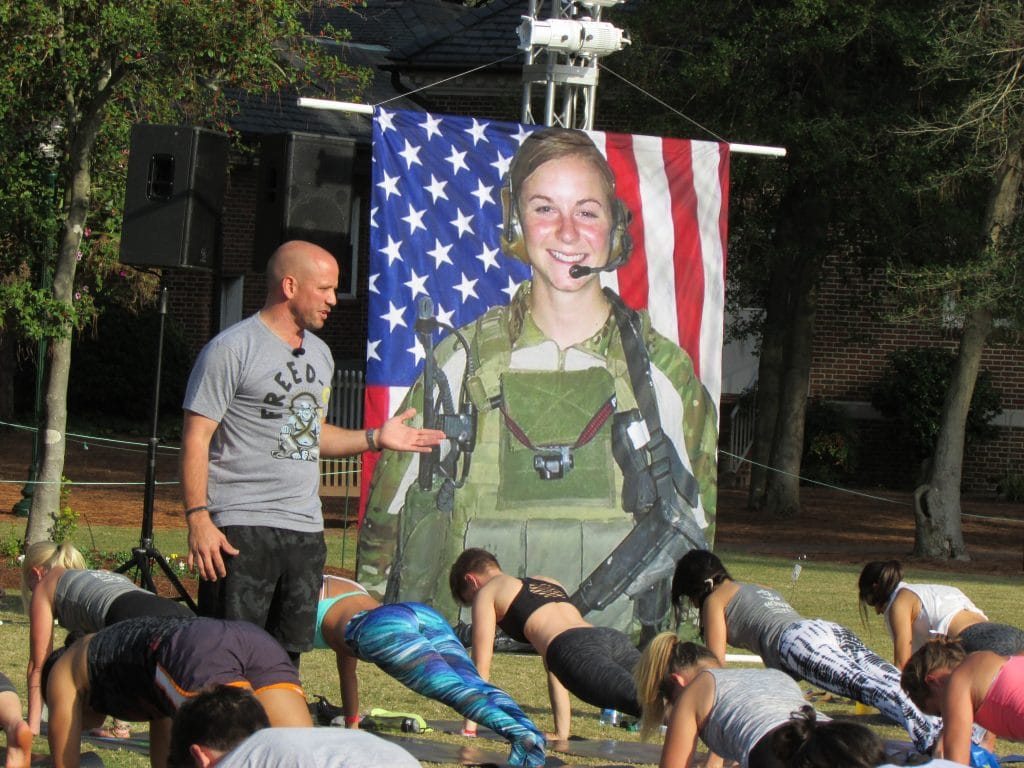CrossFit Hero WODs are designed as benchmarks. This means that you will be doing the same workout sometime in the future.
It’s recommended you keep your score somewhere – on paper or electronically.
So when you do the workout again you can compare your results.
You’ll be able to see how far you’ve come in your fitness level.
Some hero WODs are short and some are long but one thing’s for sure – they’re not easy
.
What is White?
White is a Hero WOD. They’re named after the men and women in the military who lost their lives serving our country.
This one was named after a female Army Lieutenant who served in Afganistan. (More about her later.)
This workout is For Time (FT). It’s 5 rounds of:
- 3 rope climbs (15ft)
- 10 toes-to-bars
- 21 overhead walking lunges (45/35 lb plate)
- 400 meter run.
The workout can be scaled (or modified) which will be discussed in the scaling section.
Tips/Strategies
Sometimes you need a strategy to get through a CrossFit WOD. This is one of those times.
A few tips and strategies to succeed in this workout – without injuries or over exhausting yourself are:
Pace yourself – Focusing on good technique wins the race. Remember, you have to do 5 rounds.
Don’t start out super fast and then lose all your energy and stamina in round 3. You will most likely lose time that way.
Don’t look to see what others are doing. Get a pace that’s challenging for you.
Push yourself – Only you know how hard an exercise is feeling to you. So make sure you’re keeping yourself challenged.
The WOD should feel like you’re working hard. If you’re thinking “I’m comfortable here” then bring things up a notch.
On the other hand, if you’re thinking “I think I’m gonna pass out” then bring things down a notch.
One of the great things about WODs is that you go at your level, not someone else’s.
Take breaks – But not for too long. So, for example, in this workout, you need to hold onto a bar after you’ve worked your hands gripping the rope.
Take a long enough break to give your hands a little recovery room.
You can also break down the toes-to-bar by doing as many as you can in one shot and then doing 2-3 at a time after that.
For the overhead walking lunges, it’s best if do them without breaks. If you do, you avoid having to lift the plate overhead more than once.
Also, you can always use a lighter plate. You don’t have to Rx every workout.
How the White WOD came about?
“White” was the first CrossFit female Hero WOD. It was posted on crossfit.com as the workout of the day for Tuesday November 8, 2011 (111108).
The same WOD was posted for the second time on June 29, 2017 (170629). Almost six years later. Athletes should have seen some improvement.
The next female hero WOD was posted in 2014.

Who Was White?
According to CrossFit.com:
U.S. Army First Lieutenant Ashley White, 24, of Alliance, OH, assigned to the 230th Brigade Support Battalion, 30th Heavy Brigade Combat Team, North Carolina National Guard, based in Goldsboro, NC.
She died on October 22, 2011, in Kandahar province, Afghanistan, from wounds suffered when insurgents attacked her unit with an improvised explosive device.
She is survived by her husband Captain Jason Stumpf, her parents Robert and Deborah, brother Josh, and sister Brittney.
How to Scale White?
First and foremost, always be realistic about your physical strength and ability.
If you know you can’t handle the weight required or your technique for one of the exercises is not there yet – go ahead and scale.
There’s no shame in scaling. No one’s judging. If someone is, that person should be kicked out of the box. CrossFit is about “forging elite fitness” NOT “forging injuries”.
Scaling is how you build real strength. And how you can compare your results from previous workouts.
So if you need to scale because of an injury or not having the technique down, it’s not only OK but highly recommended.
Below is a breakdown for the rope climb, toes-to-bar, and walking lunges.
Rope Climb
If this is your first time doing rope climbs, you can scale by doing progressions.
One progression is what’s called the “rope walk”.
This is done by standing in front of the rope and grabbing hold of it with arms extended above you.
Keeping your body straight, you then “walk” yourself down to the floor by using your hands. Your descent is finished when you’re lying on the floor.
Back and shoulders should be touching the floor. You then “walk” yourself up until you’re standing.
Another progression is hanging from the rope. With your arms extended above you, grab the rope.
While hanging, bring your knees up. The goal is to bring your knees higher than your hips. Hold this position for 5-10 seconds.
Toes-to-bar
If your toes-to-bar technique is lacking, a progression you can try it on the floor.
You do this by lying on the floor with a rig overhead. Your arms should be straight while you hold the rig.
With straight legs, lift your feet off the ground and bring them up until they touch the rig.
Another progression is doing knee lifts from the bar. So while hanging from a bar, bring the knees up. The knees should stay together. The goal here is to bring the knees up above hip level.
Walking lunges
If your lunge technique is really off, you’ll want to scale walking lunges to static lunges.
In a static lung, you keep one foot forward and the other back. In other words, you don’t have to move your feet.
Staying on the heel of the front foot, bend both knees until the knee of the back leg touches the floor.
If you can’t go down that far then go down as far as your body allows.
If you have static lunges down, you can scale with either forward or back lunges.
In forward lunges, you’re taking a step forward with one foot and bending both knees to lunge.
In back lunges, you’re taking a step backward with one foot and bending both knees into a lunge. In both – forward and back – lunges, you’re bringing the moving foot back to starting position.
Conclusion
This hero WOD may only have four movements with relatively low reps but it’s deceiving. Each exercise has its own level of difficulty.
The main thing to keep in mind when doing this WOD is maintaining a flow of pace.
Keeping records of your performances is also key to making improvements. The next time you do this workout, you can look back and see how much you’ve improved.
That’s what fitness is all about.

